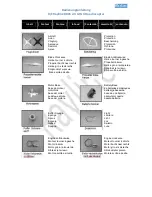
08
Familiarize yourself with these safety instructions before your first flight.
Safety
visual line
of sight
400 ft
(120 m)
100 ft (30 m)
5 miles (8 km)
400 ft
(120 m)
visual line
of sight
400 ft
(120 m)
100 ft (30 m)
5 miles (8 km)
visual line
of sight
400 ft
(120 m)
100 ft (30 m)
5 miles (8 km)
visual line
of sight
400 ft
(120 m)
100 ft (30 m)
5 miles (8 km)
visual line
of sight
400 ft
(120 m)
100 ft (30 m)
5 miles (8 km)
visual line
of sight
400 ft
(120 m)
100 ft (30 m)
5 miles (8 km)
Power Management
Environmental conditions, payload, and flying style can
affect power consumption. Use the DroneDeploy flight
data display to monitor the battery voltage during flight.
If the battery reaches 25%, IRIS-M lands automatically at
the current position, indicated by a blinking yellow status
LED and a quick repeating tone. If IRIS-M reaches the
low battery limit during a mission, it returns to the launch
point before landing.
Injury Prevention
IRIS-M has powerful motors and high-speed propellers. Never
place your hands near propellers while IRIS-M is armed or the
safety button displays solid red. Always press the safety button
until it displays blinking red before handling the copter. Always
follow the preflight and postflight steps in the order described
in this manual, and remain attentive at all times while flying.
Environmental Awareness
Don’t fly in low light, high winds, rain, or other conditions that might impede
visibility. Before you fly, assess the features of your flying area. Determine
the boundaries of the safe flying area, and be prepared to recover the copter
manually if it goes outside this area. Be aware of any risks at your location,
including bodies of water, structures, trees, etc. Designate a few areas as safety
zones where you can safely land the copter in case of an unsafe situation.
Location
Always fly in an open area away from
people and buildings; do not attempt to
fly indoors or in a confined space. Do not
fly over people, near airports, or in any
situation that could pose a hazard to those
around you. Always fly within your line
of sight and in compliance with local
regulations. IRIS-M does not avoid
obstacles on its own. As the operator,
it is your job to recognize and avoid
obstructions while flying.











































